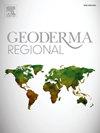松木、云杉和桦木采伐残余物使土壤渗透水中的碱离子浓度随硝酸盐浓度的增加而增加
IF 3.3
2区 农林科学
Q2 SOIL SCIENCE
引用次数: 0
摘要
本研究的目的是确定苏格兰松、挪威云杉和白桦的采伐残桩对采伐迹地生根深度以下渗滤水中碱基阳离子浓度的影响。第二个目的是确定硝酸盐和溶解有机碳的浓度是否与渗透水中碱阳离子的浓度有关。一个挪威云杉占主导地位的林分被清除,从邻近的和类似的林分中提取云杉、松树和桦树的伐木残留物。在土壤表面建造含有40 kg m - 2新鲜树枝的桩,覆盖60 cm × 60 cm的面积,即首次安装的渗湿计的整个表面积。零张力渗滤仪通过伐木残渣桩和土壤剖面收集土壤渗滤水,深度为地表以下40厘米。2016-2017年每隔4 - 6周采集渗滤水进行化学分析,测定钙、镁、钾浓度。云杉、松木和桦木的采伐残余物引起了渗滤水中碱阳离子浓度的增加,其中以桦木残余物的浓度最高。溶解有机碳浓度始终较低,且与碱阳离子无关。在大桩中设置采伐残留物是为了限制部分砍伐面积,这导致桩下硝酸盐浓度升高,本研究表明硝酸盐浓度与碱阳离子浓度升高有关。本文章由计算机程序翻译,如有差异,请以英文原文为准。
Pine, spruce and birch logging residues on a clear-cut increase base cations concentrations in soil percolation water along with nitrate concentrations increase
This study's aim was to determine the effect of logging residue piles of Scots pine, Norway spruce and silver birch on the base cation concentrations in percolation water below the rooting depth in a clear-cut. The second aim was to determine if the concentrations of nitrate and dissolved organic carbon were related to the concentrations of base cations in percolation water. A Norway-spruce-dominated stand was clear-cut, and logging residues were taken from spruce, pine, and birch trees from the adjacent and similar forest stand to the clear-cut. Piles containing 40 kg m−2 of fresh branches were constructed on the soil surface, covering a 60 cm × 60 cm area, i.e. the whole surface area of the lysimeter that was first installed. A zero-tension lysimeter collected soil percolating water through a logging residue pile and soil profile to a depth of 40 cm below the surface of the ground. Percolation water was collected for chemical analysis at 4–6-week intervals during 2016–2017 and the concentrations of calcium, magnesium and potassium were determined. Logging residues of spruce, pine, and birch caused increased concentrations of base cations in percolation water, and the highest concentrations were associated with birch residues. Dissolved organic carbon concentrations were always low and were not correlated with base cations. Logging residues are located to restrict parts of a clear-cut area in large piles, and this causes elevated concentrations of nitrate below the piles: this study showed that nitrate concentrations were related to the elevated concentrations of base cations.
求助全文
通过发布文献求助,成功后即可免费获取论文全文。
去求助
来源期刊

Geoderma Regional
Agricultural and Biological Sciences-Soil Science
CiteScore
6.10
自引率
7.30%
发文量
122
审稿时长
76 days
期刊介绍:
Global issues require studies and solutions on national and regional levels. Geoderma Regional focuses on studies that increase understanding and advance our scientific knowledge of soils in all regions of the world. The journal embraces every aspect of soil science and welcomes reviews of regional progress.
 求助内容:
求助内容: 应助结果提醒方式:
应助结果提醒方式:


